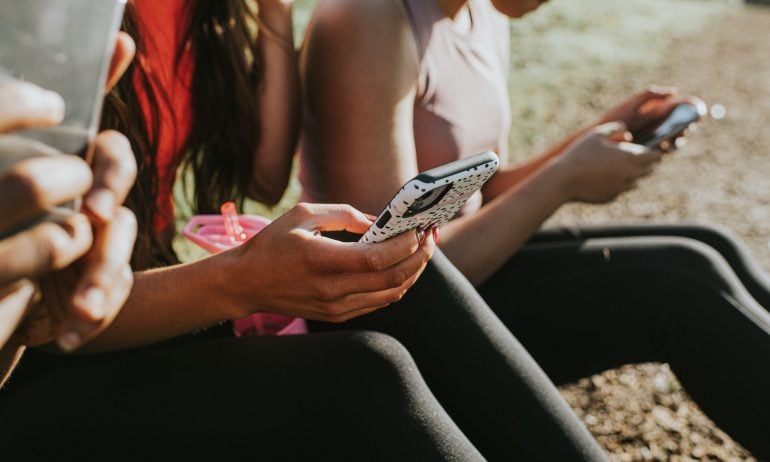What Are Peer-to-Peer Payments?
Peer-to-peer payment services let you use a bank account or a credit or debit card to pay friends or family from your phone.

Many, or all, of the products featured on this page are from our advertising partners who compensate us when you take certain actions on our website or click to take an action on their website. However, this does not influence our evaluations. Our opinions are our own. Here is a list of our partners and here's how we make money.
ALSO CONSIDER: PayPal || Venmo || Zelle || Cash App || Apple Pay Cash || Top P2P payment apps
Key takeaways about P2P payments
P2P stands for "peer-to-peer." P2P payments let you send money directly to another person.
P2P payment services allow users to quickly send funds while keeping their bank account details private.
Popular P2P payment services include Cash App, PayPal, Venmo and Zelle.
Banks and credit unions aren’t responsible for money lost from P2P scams.
What is P2P payment?
Peer-to-peer payments, or P2P payments, let you send money directly to another person. P2P payment systems — also known as money transfer apps, like Venmo, PayPal and Cash App — allow users to send and receive money from their mobile devices through a linked bank account or card.
Here’s what to know about how P2P payments work, how to choose a service and how to use a service safely.
» Already have a P2P app in mind? Skip ahead to read more about a few of our favorites
How P2P payments work
With P2P payments, users can quickly send funds while keeping their bank account details private. All that’s required to send a payment is the recipient’s email address or phone number; you can use one of those pieces of information to add someone as a contact within the app. Generally, these services are free and make splitting bills with friends and family painless.
Say you’re out to dinner with your cousin Charlie and want to split the check. Charlie pays the bill using his card. You take out your phone and open your app of choice, pick Charlie from your contact list (or add him using his email or phone number), type the amount you want to send, and voilà — you've paid Charlie back. If you have a PIN set up, depending on the app you’re using, you’ll need to enter it to open the app or to complete the payment.
Once Charlie receives the money, he can leave it in his P2P account for the next time it’s his turn to pay, or he can transfer it to his bank account. Different services may have different steps or requirements, but most work something like this.
» Want to explore your options? See the best ways to send money to an individual in the U.S. or abroad
Forbright Bank Growth Savings

4.25%
$0

Member FDIC
Axos ONE® Savings

4.66%
$1,500

Member FDIC
Varo Savings Account

5.00%
$0

Member FDIC
E*TRADE Premium Savings

4.00%
$0
Which P2P payment service should you use?
Choose a service that your friends and family already use. That will make exchanging money more convenient. There are plenty of P2P apps to choose from these days. Paying friends and family by phone or computer was first popularized by PayPal. Venmo (which is owned by PayPal) and others now offer similar services. P2P payments are also available through banks and credit unions, and on social media networks, including Facebook.
If you're the one choosing the payment service for your friends and family, check out a quick summary of our favorites below or read our more in-depth overview of top peer-to-peer payment apps.
Cash App (see review) |
|
PayPal (see review) |
|
Venmo (see review) |
|
Zelle (see review) |
|
Are P2P payments safe?
Though all of the major P2P systems encrypt, or shield, your financial information, some have been hacked or used by scammers. Review a provider’s security procedures and fraud policies before signing up, and take precautions when using P2P payment services, because once you’ve authorized a payment, you might not be able to get your money back. Banks and credit unions aren’t responsible for money lost from P2P scams.
How to safely make and receive P2P payments
Here’s what you can do to help P2P payment services keep your money safe:
» Protect yourself: Find out how to avoid P2P scams and what to do if you can’t
How quickly do P2P payments post to the recipient's account?
Transaction notifications are sent right away, and you can immediately use the money you receive within a P2P app to send money to someone else within the app. But if you choose to transfer your money out of the app, those funds may take one to three business days to arrive in your linked bank account. Some providers are faster (funds from Zelle transfers are available in your bank account within minutes), and some also offer instant transfers for a fee.
What do P2P payments cost?
Generally speaking, you can make P2P payments from a linked bank account or straight from the P2P account for free. But some providers charge fees — typically 3% to process payments drawn from a credit or debit card, for example — for other payment methods.
» Want to send money on social media apps? Read about social media money transfers
Frequently asked questions about P2P payments
Here are answers to some common questions about peer-to-peer payments.
What does P2P mean?
“P2P” stands for peer-to-peer and means that you’re sending money directly to another person.
What is P2P payment?
A P2P payment is a payment you make directly to another person using a P2P payment service. With P2P payments, users can quickly send funds while keeping their account details private; all that’s required to send a payment is the recipient’s email address or phone number.
On this page
On this page










